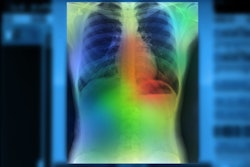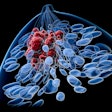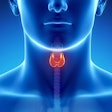Lung imaging biomarkers can inform patient selection for endobronchial ultrasound-guided transbronchial needle aspiration (EBUS-TBNA), suggest findings published February 19 in the American Journal of Roentgenology.
Researchers led by Sang Min Lee, MD, from the University of Ulsan in Seoul, South Korea found that pN2b disease (that is, cancer in the lymph nodes) was uncommon in lung cancer patients with radiologic N0 disease (non-small cell lung cancer [NSCLC] that doesn't have any radiologic evidence of lymph node metastasis), regardless of indications for EBUS-TBNA. However, pN2b increased in prevalence in patients with radiologic N1 disease (NSCLC that has spread to lymph nodes in the lung).
“This information … could help guide decisions to use invasive mediastinal staging to help detect occult pN2 disease,” Lee and co-authors wrote.
Some lung cancer patients are recommended for EBUS-TBNA, which evaluates lungs for metastatic mediastinal lymph nodes. This, in turn, defines pN2 disease. However, the researchers pointed out that EBUS-TBNA has higher costs and complications and may be limited in availability.
The latest edition of the lung cancer TNM staging system introduced two N2 subcategories: N2a, which represents single-station involvement in N2 disease; and N2b, which represents multistation involvement.
The Lee team studied the prevalence and risk factors for pN2 disease in patients undergoing resection of lung cancer assessed as having radiologic N0 or N1 disease.
The retrospective study included data from 3,581 lung cancer patients with an average age of 63.8 years. All patients underwent chest CT and FDG PET/CT showing radiologic N0 or N1 disease before resection between 2015 and 2021. The team used chest CT data to assess tumor characteristics.
Of the total patients, 1,936 had radiologic N0 disease without EBUS-TBNA indication, 1,348 had radiologic N0 disease with EBUS-TBNA indication, and 297 had radiologic N1 disease. The researchers reported that these groups had a pN2a disease prevalence of 4.1%, 6.5%, and 18.5%, respectively. And the pN2b disease prevalence was 1.2%, 2.4%, and 14.8%, respectively.
 Images depict a 59-year-old woman with lung cancer. (A) Axial image from preoperative chest CT shows 2.1-cm solid nodulein right upper lobe (arrow). Primary tumor has central location and shows lobulation. Based on chest CT and FDG PET/CT, patient was categorized as having radiologic N0 disease. Further evaluation by EBUS-TBNA was indicated accordingto guidelines due to primary tumor’s central location. However, EBUS-TBNA was not performed. Patient underwent rightupper lobectomy. Pathologic analysis of resection specimen revealed histologic type for primary tumor of adenocarcino-ma and metastatic right lower paratracheal lymph node. Based on resection specimen, patient was assessed as havingpT2a pN2a disease. (B) Axial image from preoperative chest CT shows normal size of right lower paratracheal lymph node(arrow). (C) Axial fused image from preoperative FDG PET/CT shows no abnormal uptake in right lower paratracheal lymphnode (arrow). Although metastatic mediastinal lymph node was not detected on preoperative imaging, patient had twopreoperative risk factors (pure-solid nodule and lobulation) for pN2 disease in patients with radiologic N0 disease withindication for EBUS-TBNA. Images and caption courtesy of the ARRS.
Images depict a 59-year-old woman with lung cancer. (A) Axial image from preoperative chest CT shows 2.1-cm solid nodulein right upper lobe (arrow). Primary tumor has central location and shows lobulation. Based on chest CT and FDG PET/CT, patient was categorized as having radiologic N0 disease. Further evaluation by EBUS-TBNA was indicated accordingto guidelines due to primary tumor’s central location. However, EBUS-TBNA was not performed. Patient underwent rightupper lobectomy. Pathologic analysis of resection specimen revealed histologic type for primary tumor of adenocarcino-ma and metastatic right lower paratracheal lymph node. Based on resection specimen, patient was assessed as havingpT2a pN2a disease. (B) Axial image from preoperative chest CT shows normal size of right lower paratracheal lymph node(arrow). (C) Axial fused image from preoperative FDG PET/CT shows no abnormal uptake in right lower paratracheal lymphnode (arrow). Although metastatic mediastinal lymph node was not detected on preoperative imaging, patient had twopreoperative risk factors (pure-solid nodule and lobulation) for pN2 disease in patients with radiologic N0 disease withindication for EBUS-TBNA. Images and caption courtesy of the ARRS.
On multivariable analysis, the team reported the following independent risk factors for pN2 disease in patients with radiologic N0 disease without EBUS-TBNA indication: female sex (odds ratio [OR] = 1.66, with 1 as reference), larger size of the tumor’s solid portion (OR = 1.05), pure-solid nodule (OR = 5.53), and spiculation (OR = 2.66).
It also reported the following factors tied to radiologic N0 disease with EBUS-TBNA indication: younger age (OR = 0.97), pure-solid nodule (OR = 1.75), and lobulation (OR = 1.96). Finally, the team found the following factors associated with radiologic N1 disease: younger age (OR = 0.973), female sex (OR = 2.91), and spiculation (OR = 2.81).
The study authors suggested that these results support more detailed risk assessment in these patients, considering the limitations of EBUS-TBNA.
“Although EBUS-TBNA is currently indicated in all patients with radiologic N1 disease given this group’s greater prevalence of pN2 disease, it may be impractical to perform EBUS-TBNA in all such patients in real-world clinical settings,” they wrote.
The authors added that the currently recognized indications for EBUS-TBNA could be combined with complementary risk factors for pN2 disease to better select patients for this exam.
The full study can be accessed here.



















